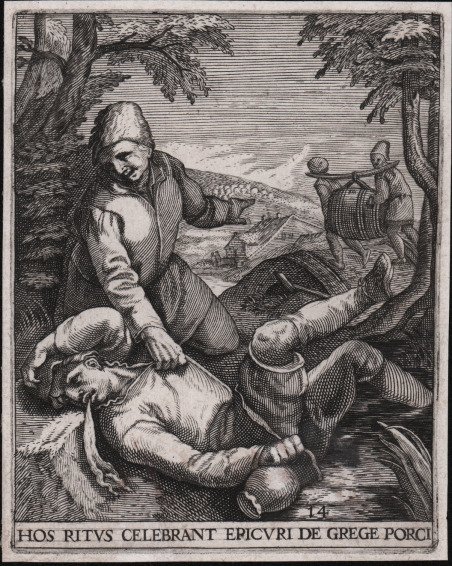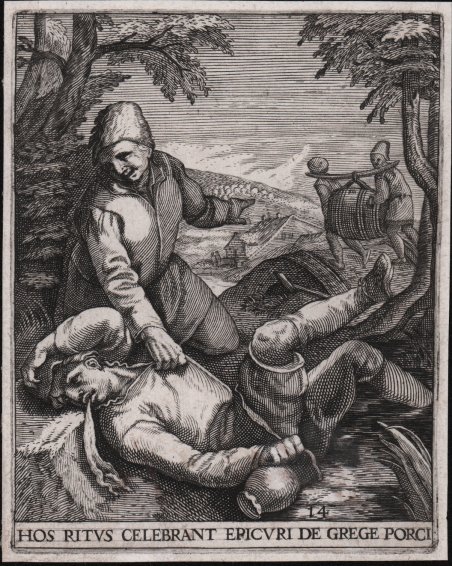Bulino, 1596, privo di data e firma. Da un soggetto di Karel van Mander. In basso il titolo "HOS RITUS CELEBRANT EPICURI DE GREGE PORCI" e la numerazione "14". Bella impressione della prima edizione, stampata su carta vergata coeva, con margini sottili, ottimo stato di conservazione. Un giovane ubriaco giace vomitando in un fosso. È sorretto dal suo compagno, che indica due uomini sullo sfondo che portano via un grosso barile di birra. Due portatori di barili sobri sono in grado di trasportare un barile pieno di birra, mentre un ubriaco non può sopportare nulla. Morale: attenzione al bere smodato con tutte le sue conseguenze negative. Emblema n. 14 in Emblemata saecularia, mira et iucunda varietate saeculi huius mores ita exprimentia, stampato nel 1596 e n. 35 nella seconda edizione del 1611. Le incisioni erano principalmente da soggetti di Hans Bol, Hieronymus Bosch, Pieter Breughel, Karel van Mander, Maarten de Vos ecc. I De Bry sono noti soprattutto come editori di libri attivi a Francoforte sul Meno e per qualche tempo nella vicina Oppenheim. Erano famosi per i progetti in più volumi riccamente illustrati, come i monumentali volumi che trattano l'America con molte tavole derivate da disegni di John White. Theodor de Bry (1528-1598) ebbe una formazione da orafo e i suoi primi anni li trascorse a Liegi, nei Paesi Bassi meridionali, e a Strasburgo, dove nel 1560 si iscrisse alla Corporazione degli Orafi. Si sposò e i suoi figli Johann Theodor (nato nel 1563) e Johann Israel (nato nel 1565) divennero in seguito suoi apprendisti. Viaggiò ad Anversa (1577-1585) e a Londra (1585-1588), dove si dedicò all'incisione. Il successivo trasferimento a Francoforte vide un passaggio decisivo alla pubblicazione di libri. Contemporaneamente alla pubblicazione di libri, i De Bry produssero libri di emblemi e stamparono album amicorum come gli Emblemata nobilitati (1592) e gli Emblemata saecularia (1596). La maggior parte delle stampe sono essenzialmente notevoli copie miniaturizzate di opere di Sebald Beham, Pieter Bruegel il vecchio, Albrecht Dürer, Hendrick Goltzius e molti altri. Bibliografia Hollstein, Dutch and Flemish etchings, engravings and woodcuts c.1450-1700 (240-287). Engraving, 1596, without signature. After Karel van Mander. Lettered ‘HOS RITUS CELEBRANT EPICURI DE GREGE PORCI’ and numbered ‘14’. A fine impression of the first issue, printed on contemporary laid paper, with thin margins, very good condition. A drunken young man lies vomiting in a ditch. He is held by his mate, who points to two men in the background carrying away a large barrel of beer. Two sober barrel carriers are capable of carrying a full barrel of beer, while a drunk can't take anything (anymore). The moral: beware of immoderate drinking with all its ill consequences. Emblem No. 14 in Emblemata saecularia, mira et iucunda varietate saeculi huius mores ita exprimentia, 1596 and No. 35 in the second edition of 1611. The engravings were mainly after Hans Bol, Hieronymus Bosch, Pieter Breughel, Karel van Mander, Maarten de Vos etc. The De Brys are best known as book publishers who were active in Frankfurt am Main and for some time in nearby Oppenheim. They were renowned for lavishly illustrated multi-volume projects such as the monumental volumes treating America with many plates derived from drawings by John White. Theodor de Bry (1528-1598) was trained as a goldsmith and his early years were spent in Liège in the southern Netherlands and Strasbourg, where in 1560 he enrolled as a member of the Guild of Goldsmiths. He married and his sons Johann Theodor (b.1563) and Johann Israel (b.1565) later became his apprentices. He travelled to Antwerp (1577-1585) and London (1585-1588) which saw a transition to engraving. The subsequent move to Frankfurt saw a decisive shift into book publishing. At the same time as publishing books, the De Brys produced emblem books and printed alba amicorum such as the Emblemata nobilitati (1592) and Emblemata saecularia (1596). Most of the prints are essentially remarkable miniaturised copies of works by Sebald Beham, Pieter Bruegel the elder, Albrecht Dürer, Hendrick Goltzius, and a myriad of others. Bibliografia Hollstein, Dutch and Flemish etchings, engravings and woodcuts c.1450-1700 (240-287). ' Cfr.


Scopri come utilizzare
Scopri come utilizzare

